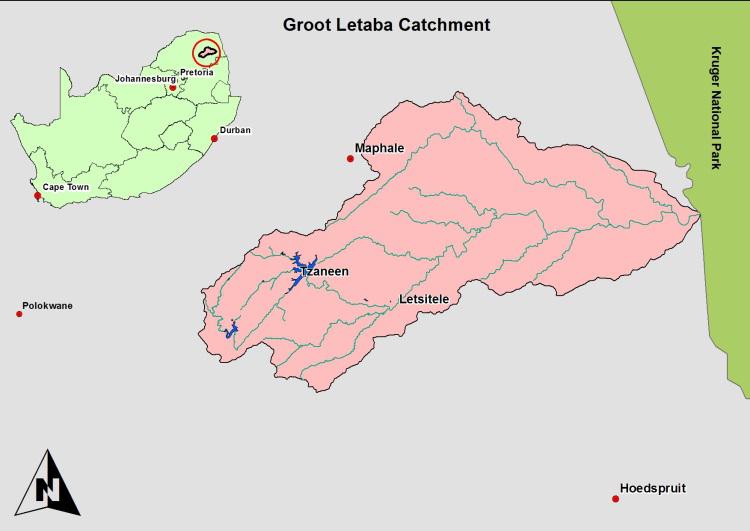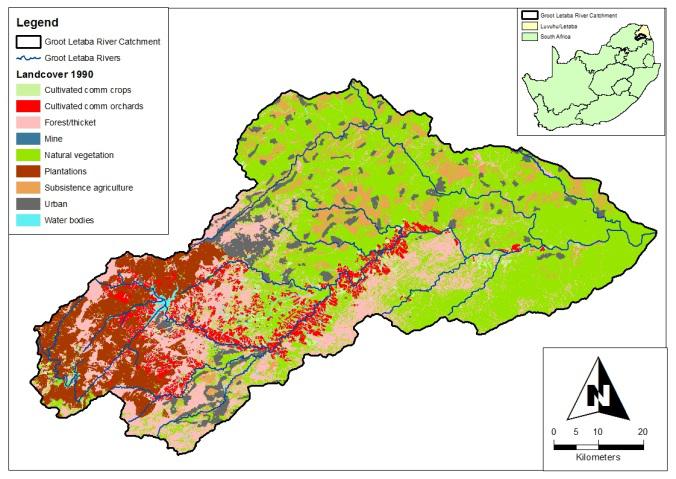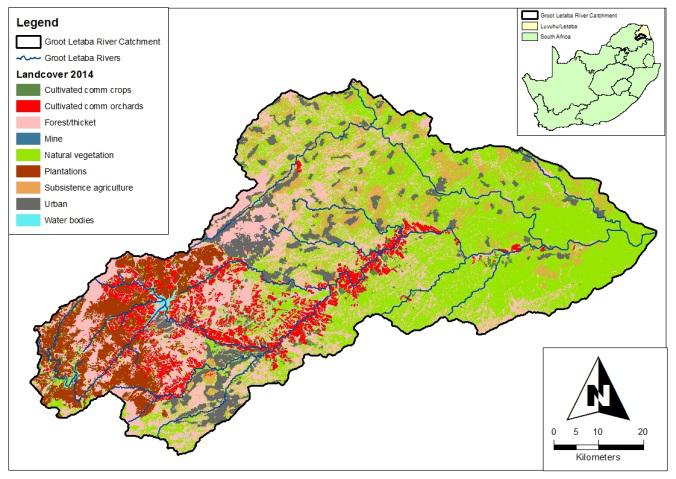By Bruce Lankford (University of East Anglia), and Jon McCosh, Mlungisi Shabalala and Lutendo Mugwedi (Institute of Natural Resources)
Abstract
In this piece we argue that; 1) an absence of purposive managed water allocation can be observed in some South African catchments; and 2) within this absence, individual actors can gain and shore up their own allocations; 3) with the result that, on the surface, commercial fruit growers look to be resilient and efficient, but wider longer-term catchment production and ecosystems resilience, especially during prolonged drought, is at risk; and finally, 4) water governance within South Africa needs to be pursued more rigorously in order to effect efficient, flexible and equitable water allocation in both drought and non-drought times.
Introduction
The Institute of Natural Resources (INR) is currently leading the South African case study for a project titled: Increasing resilience to water-related risk in the UK fresh fruit and vegetable system. The INR is working with a number of UK research institutions (Cranfield University, University of East Anglia, NIAB EMR (formerly East Malling Research), University of Oxford). Essentially this project recognises that the UK is heavily reliant on fresh fruit and vegetables from other countries, many of which are water stressed (Hess & Sutcliffe, 2018). Thus the resilience of UK food systems is to a large extent dependent on the resilience of exporting countries to water-related risk. South Africa is a major producer of fresh fruit to the UK market, and is subject to water stress, particularly under the current drought conditions.
We have been engaging with farmers, industry bodies and other value chain actors to understand the extent to which fruit producing areas in South Africa are resilient to water-related risks. A quantitative and qualitative case study is being done at Tzaneen in Greater Letaba catchment, Limpopo Province; and a qualitative case is planned for the Western Cape Province, given the recent drought experienced in this province.
 The Groot Letaba Catchment, Limpopo Province
The Groot Letaba Catchment, Limpopo Province
In parallel to those case studies, the International Water Security Network (IWSN) is currently funding research into how ecological infrastructure (EI) can contribute to water security in the uMngeni River basin, KwaZulu-Natal. Farmers within the uMngeni catchment are substantial users of water, particularly through irrigated agriculture. While transformed farmlands are not strictly ecological infrastructure, these areas do provide certain ecosystem services. The manner in which farmlands are managed, particularly in relation to water use can either enhance or diminish the extent to which these services are provided. Given the substantial water use in irrigated agriculture, we posit that better managed farms can contribute to improved water security within the catchment. An additional question we ask is: What lessons can be learnt that are also of relevance to the uMngeni River catchment?
What we have been doing to understand resilience to water-related risk in the fruit sector?
Our research efforts have been concentrated in the Groot Letaba catchment in Limpopo as we have been able to readily access qualitative and quantitative data through engagements with farmers, industry bodies and other sector stakeholders including water user associations, irrigation boards and professional consultants. The Western Cape has been more challenging in that farmers and sector stakeholders have been focussed on surviving through a particularly bad drought.
 The Tzaneen dam is the largest impoundment in the Groot Letaba Catchment. The raising of the dam wall has been approved by the National Department of Water and Sanitation – but how will this increased storage be governed?
The Tzaneen dam is the largest impoundment in the Groot Letaba Catchment. The raising of the dam wall has been approved by the National Department of Water and Sanitation – but how will this increased storage be governed?
In terms of quantitative assessment, an assessment of ‘virtual water’ exports from the Groot Letaba is being conducted to quantify the proportion of productive water in the Groot Letaba that is exported abroad (as virtual water) and in particular to the UK. We have also assessed and documented different practices being applied at orchard, farm, system and catchment scale to increase water use efficiency and mitigate the impact of droughts. In addition to this, the role of water governance was increasingly highlighted as a major influence on water resilience.
Two workshops were held in the Groot Letaba and Western Cape, using the process of game design by stakeholders to explore recent experiences and future scenarios related to changing water scarcity, irrigation management and catchment resilience. Games can be valuable tools for increasing understanding of complex systems: they are a useful language for expressing complexity, they allow emotional responses to be created, and they are a safe space for exploring real-world systems.
 Workshop participants in Stellenbosch, Western Cape
Workshop participants in Stellenbosch, Western Cape
Through the workshops different articulations of water risk and resilience were collected, which can be summarised as follows:
- Where resilience is embedded in headroom (i.e., a buffer of additional available water for times of stress) available to farmers, water-risk emerges where headroom is reduced, for example when farmers use increased efficiencies to increase the area under production rather than to ‘bank’ this water for times of scarcity.
- A trade-off exists between water-risk and food quality risk where farmers are required to overproduce to compensate for unfavourable seasonality and to meet retailers’ quality requirements.
- Similarly, a trade-off exists between efforts to reduce water use, (e.g., through the use of organic amendments or mulching which can improve soil water retention and reduce run-off) and food safety risk (less ‘splash’ from contaminated water).
- Water-risk is a matter of drought, environmental impact and reputational risk, resources scarcity and distribution.
- Resilience is illustrated as a matter of catchment management, community engagement, incentivising common goals and action, or alternatively as a matter of actions that make specific sectors more resilient.
What have we learnt regarding water allocation that is of relevance to the uMngeni Catchment?
It is immediately apparent that the governance of water at different scales is important. We consider three geographic scales in this discussion:
Governance at the catchment and water management area (WMA) scale is an important factor in regulating, monitoring and enforcing equitable water allocation within a catchment, as documented in this recent IWSN blog. The noticeable lack of the Department of Water and Sanitation’s (DWS) participation in water management in the Groot Letaba is relevant here. For example, certain functions that are the responsibility of the DWS and funded via the water allocation licence levy, such as dam operating rules and maintenance of infrastructure, are failing. Consequently, water users are not only paying for their licences, but are burdened with additional out of pocket costs to procure services that should be provided by DWS.
At an intermediate scale, the role of functioning Irrigation Boards (IBs) and Water User Associations (WUAs) has proven to be important in the absence of proper governance at a larger scale. The Groot Letaba Water User Association has implemented increasingly proactive restrictions over time to manage the supply of water to irrigators, while ensuring supply to urban areas can be maintained during drought periods. However, even with reasonable local governance through WUAs, unscrupulous irrigators do bend and break the rules. Examples of this include unregistered and unmetered water pumps, unregistered boreholes (used especially in droughts) and even tampering with water meters.
At farm scale, rules for irrigation management are evolving with each drought event. Firstly, we see the transition from flood/furrow irrigation, to sprinkler to microjets and to drip. With increases in technology and the drive to maintain productivity, farmers are increasingly removing older, less productive orchards and replacing with younger and more water efficient orchards – as the average tree age across the farm decreases, so efficiency increases. While this reflects a higher capital cost for more regular replacements, the water productivity gains tend to offset this. Additionally, increasing the density of trees per hectare further increases the productive evapotranspiration and reduces unproductive losses, all of which contribute to increased efficiencies. Farmers are also starting to monitor application rates and use soil probes to inform irrigation scheduling.
While national government is de jure responsible for water allocation within catchments, we suggest that the de facto water scarcity within catchments is forcing local governance structures, in the case of the Groot Letaba, to better manage their water resources. There exists a risk that the more powerful stakeholders within the catchment will ‘capture’ more of the water resource, without national government refereeing equitable water allocation. This is particularly relevant where efficiency increases on farms are resulting in increased areas planted to orchards, suggesting that licences should be reviewed, especially considering that some were established 50 years ago when water efficiencies were far lower.
Our analysis of land cover changes between 1990 and 2014 indicate an increase from 28 000ha to 36 000ha under fruit orchard production in the Groot Letaba, yet water allocations for irrigation haven’t changed over this period (Image source: Geoterra Image).
Implications for water allocation governance
In terms of the challenges associated with water allocations, we have learnt that in the face of reduced governance, various barriers to allocation emerge. If we consider the three main types of institutional mechanisms to change patterns of allocation (Dinar et al., 1997), namely (1) market mechanisms (pricing and trading) to reduce withdrawals; (2) administrative decisions (licences and rights) to cap withdrawals; and (3) collective user management (informal rights and practices), we notice that these three mechanisms are not playing out as intended in the Groot Letaba.
Firstly, water allocation seems to be residual in quantity in that a large quantity of the available water has already been allocated, leaving little room for re-allocating the balance. Secondly, water allocation is a residual in terms of process and by this we mean that managed water allocation via the three allocation mechanisms is largely absent. Instead, we have identified a number of ‘hidden’ or ‘residual’ allocation factors that impede managed water re-allocation and equitable sharing of water resources. These factors are not easy to pin down and define as they tend to be hidden or downplayed, but we suggest that the following factors be considered:
Legacies: historical effects of previous allocation. For example, water allocations through irrigation schemes to agriculture in the 1960s-1980s that didn’t consider environmental flows or increasing urban demands in the future, but are enabled through existing lawful use under the National Water Act 36 of 1998.
Gaps (governance): Diminished agency, capacity or metrics to inform water allocation. For example, a lack of capacity to direct the science and practice of water allocation by national government.
Subterfuge: Misleading or wilful ignorance on the part of key water users or abstractors. For example, boreholes without water use licences.
Echo chambers: Dialogue that fails to break the boundary of the system and fails to transform thinking around equitable water allocation. For example, WUAs dominated by irrigators or specific interest groups, such as mining. In some cases there is a perception that agricultural use is a more ‘productive’ use than urban potable water. During workshops, irrigators bemoaned the wastage of water through leaving taps open in rural and peri-urban areas; but – how does this compare with 5% over-irrigation across 10,000ha of orchards? Thus, conversations are internally focused and fail to adequately acknowledge the needs of other stakeholders.
Implications for catchment resilience
Drawing from our research and the two workshops using games, we now can see more clearly how commercial fruit growers continue to succeed both during drought and during increasing water scarcity as they are able to use their influence and a lack of governance to lock in fruit production. Thus arguably they are ‘resilient’ in the face of water shortages.
However this ‘within-the-fruit-sector’ resilience has externalities; their resilience outsources risks to the wider catchment leading to a diminished resilience ‘for all’.
Implications for national water governance
If we consider the above hidden/residual allocation factors and the three institutional norms for water allocation, we can see that none are managed particularly well in South Africa. There are few trading options to incentivise savings. The price of water is not a factor farmers consider – it is rather the scarcity of water and maximising profit through higher production per unit of water that drives efficiency. In many cases, licences and rights are outdated and require revision; efficiencies from the 1960s were substantially lower than they are now. There is some degree of collective user management at a local scale through Water User Associations, where they are functioning, but true multi-stakeholder water management remains a challenge.
There is a pressing need to find convergence between the science of water allocation, the policy and governance of water allocation and effective participation of all stakeholders in water allocation. Figure 1 (below) outlines the situation that dominates in South Africa on the left and where we should be aiming for in terms of managed water allocation on the right.
Clearly, wider water governance has an important role to play in shaping whether water allocation is purposive and managed or whether water allocation is happening via residual effects. The parlous state of our national DWS is of grave concern and must be addressed as a priority. However, cooperative governance is a key policy objective in South Africa. It is equally the responsibility of water users to embody the spirit of the National Water Act and to work with stakeholders from other sectors to overcome the legacies and gaps; call out and penalise those involved in subterfuge and to think beyond their own sector-based interests.
Acknowledgement
This work was funded through the Global Food Security’s Resilience of the UK Food System Programme, with support from BBSRC, ESRC, NERC and Scottish Government under grant no. BB/N020499/1. Co-funding support for background research and the publication of this blog from the International Water Security Network is also gratefully acknowledged.
References
Dinar, A., Rosegrant, M., & Meinzen-Dick, R. 1997. Water allocation mechanisms. World Bank: Policy Research Working Paper #1779, Washington.
Hess, T.M. and Sutcliffe, C. 2018. The exposure of a fresh fruit and vegetable supply chain to global water-related risks. Water International.
Lankford, B., McCosh, J., Hess, T., Pringle, C., and Shabalala, M. 2018. Legacies, gaps, subterfuge and echo-chambers; Reflections on the absence of managed water re-allocation. Presentation at Stockholm Water Week 2018. Wed 29 August. Session on ‘Efficiency, sufficiency, sustainability: water allocation in river basins’



